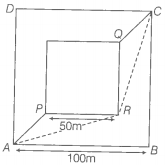4.1 Introduction
4.2 Scalars and vectors
4.3 Multiplication of vectors by real numbers
4.4 Addition and subtraction of vectors — graphical method
4.5 Resolution of vectors
4.6 Vector addition — analytical method
4.7 Motion in a plane
4.8 Motion in a plane with constant acceleration
4.9 Relative velocity in two dimensions
4.10 Projectile motion
4.11 Uniform circular motion
Summary
Points to ponder
Exercises
Additional exercises
In the last chapter we developed the concepts of position, displacement, velocity and acceleration that are needed to describe the motion of an object along a straight line. We found that the directional aspect of these quantities can be taken care of by + and – signs, as in one dimension only two directions are possible. But in order to describe motion of an object in two dimensions (a plane) or three dimensions (space), we need to use vectors to describe the above-mentioned physical quantities. Therefore, it is first necessary to learn the language of vectors. What is a vector? How to add, subtract and multiply vectors ? What is the result of multiplying a vector by a real number ? We shall learn this to enable us to use vectors for defining velocity and acceleration in a plane. We then discuss motion of an object in a plane. As a simple case of motion in a plane, we shall discuss motion with constant acceleration and treat in detail the projectile motion. Circular motion is a familiar class of motion that has a special significance in daily-life situations. We shall discuss uniform circular motion in some detail.
The equations developed in this chapter for motion in a plane can be easily extended to the case of three dimensions.
In physics, we can classify quantities as scalars or vectors. Basically, the difference is that a direction is associated with a vector but not with a scalar. A scalar quantity is a quantity with magnitude only. It is specified completely by a single number, along with the proper unit. Examples are : the distance between two points, mass of an object, the temperature of a body and the time at which a certain event happened. The rules for combining scalars are the rules of ordinary algebra. Scalars can be added, subtracted, multiplied and divided just as the ordinary numbers*. For example, if the length and breadth of a rectangle are 1.0 m and 0.5 m respectively, then its perimeter is the sum of the lengths of the four sides, 1.0 m + 0.5 m +1.0 m + 0.5 m = 3.0 m. The length of each side is a scalar and the perimeter is also a scalar. Take another example: the maximum and minimum temperatures on a particular day are 35.6 °C and 24.2 °C respectively. Then, the difference between the two temperatures is 11.4 °C. Similarly, if a uniform solid cube of aluminium of side 10 cm has a mass of 2.7 kg, then its volume is 10–3 m3 (a scalar) and its density is 2.7×103 kg m–3 (a scalar).
A vector quantity is a quantity that has both a magnitude and a direction and obeys the triangle law of addition or equivalently the parallelogram law of addition. So, a vector is specified by giving its magnitude by a number and its direction. Some physical quantities that are represented by vectors are displacement, velocity, acceleration and force.
To represent a vector, we use a bold face type in this book. Thus, a velocity vector can be represented by a symbol v. Since bold face is difficult to produce, when written by hand, a vector is often represented by an arrow placed over a letter, say  . Thus, both v and
. Thus, both v and  represent the velocity vector. The magnitude of a vector is often called its absolute value, indicated by |v| = v. Thus, a vector is represented by a bold face, e.g. by A, a, p, q, r, ... x, y, with respective magnitudes denoted by light face A, a, p, q, r, ... x, y.
represent the velocity vector. The magnitude of a vector is often called its absolute value, indicated by |v| = v. Thus, a vector is represented by a bold face, e.g. by A, a, p, q, r, ... x, y, with respective magnitudes denoted by light face A, a, p, q, r, ... x, y.
To describe the position of an object moving in a plane, we need to choose a convenient point, say O as origin. Let P and P′ be the positions of the object at time t and t′, respectively [Fig. 4.1(a)]. We join O and P by a straight line. Then, OP is the position vector of the object at time t. An arrow is marked at the head of this line. It is represented by a symbol r, i.e. OP = r. Point P′ is represented by another position vector, OP′ denoted by r′. The length of the vector r represents the magnitude of the vector and its direction is the direction in which P lies as seen from O. If the object moves from P to P′, the vector PP′ (with tail at P and tip at P′) is called the displacement vector corresponding to motion from point P (at time t) to point P′ (at time t′).
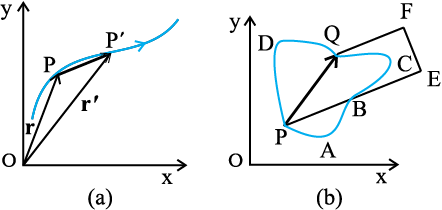
Fig. 4.1 (a) Position and displacement vectors. (b) Displacement vector PQ and different courses of motion.
It is important to note that displacement vector is the straight line joining the initial and final positions and does not depend on the actual path undertaken by the object between the two positions. For example, in Fig. 4.1(b), given the initial and final positions as P and Q, the displacement vector is the same PQ for different paths of journey, say PABCQ, PDQ, and PBEFQ. Therefore, the magnitude of displacement is either less or equal to the path length of an object between two points. This fact was emphasised in the previous chapter also while discussing motion along a straight line.
Two vectors A and B are said to be equal if, and only if, they have the same magnitude and the same direction.**
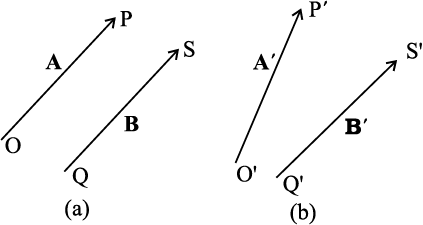
Fig. 4.2 (a) Two equal vectors A and B. (b) Two vectors A� and B� are unequal though they are of the same length.
Figure 4.2(a) shows two equal vectors A and B. We can easily check their equality. Shift B parallel to itself until its tail Q coincides with that of A, i.e. Q coincides with O. Then, since their tips S and P also coincide, the two vectors are said to be equal. In general, equality is indicated as A = B. Note that in Fig. 4.2(b), vectors A′ and B′ have the same magnitude but they are not equal because they have different directions. Even if we shift B′ parallel to itself so that its tail Q′ coincides with the tail O′ of A′, the tip S′ of B′ does not coincide with the tip P′ of A′.
* Addition and subtraction of scalars make sense only for quantities with same units. However, you can multiply and divide scalars of different units.
** In our study, vectors do not have fixed locations. So displacing a vector parallel to itself leaves the vector unchanged. Such vectors are called free vectors. However, in some physical applications, location or line of application of a vector is important. Such vectors are called localised vectors.
Multiplying a vector A with a positive number λ gives a vector whose magnitude is changed by the factor λ but the direction is the same as that of A :
|λ A| = λ |A | if λ > 0.
For example, if A is multiplied by 2, the resultant vector 2A is in the same direction as A and has a magnitude twice of |A| as shown in Fig. 4.3(a).
Multiplying a vector A by a negative number −λ gives another vector whose direction is opposite to the direction of A and whose magnitude is λ times |A|.
Multiplying a given vector A by negative numbers, say –1 and –1.5, gives vectors as shown in Fig 4.3(b).
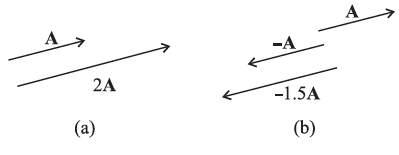
The factor λ by which a vector A is multiplied could be a scalar having its own physical dimension. Then, the dimension of λ A is the product of the dimensions of λ and A. For example, if we multiply a constant velocity vector by duration (of time), we get a displacement vector.
As mentioned in section 4.2, vectors, by definition, obey the triangle law or equivalently, the parallelogram law of addition. We shall now describe this law of addition using the graphical method. Let us consider two vectors A and B that lie in a plane as shown in Fig. 4.4(a). The lengths of the line segments representing these vectors are proportional to the magnitude of the vectors. To find the sum A + B, we place vector B so that its tail is at the head of the vector A, as in Fig. 4.4(b). Then, we join the tail of A to the head of B. This line OQ represents a vector R, that is, the sum of the vectors A and B. Since, in this procedure of vector addition, vectors are arranged head to tail, this graphical method is called the head-to-tail method. The two vectors and their resultant form three sides of a triangle, so this method is also known as triangle method of vector addition. If we find the resultant of B + A as in Fig. 4.4(c), the same vector R is obtained. Thus, vector addition is commutative:

Fig. 4.4 (a) Vectors A and B. (b) Vectors A and B added graphically. (c) Vectors B and A added graphically. (d) Illustrating the associative law of vector addition.
A + B = B + A (4.1)
The addition of vectors also obeys the associative law as illustrated in Fig. 4.4(d). The result of adding vectors A and B first and then adding vector C is the same as the result of adding B and C first and then adding vector A :
(A + B) + C = A + (B + C) (4.2)
What is the result of adding two equal and opposite vectors ? Consider two vectors A and –A shown in Fig. 4.3(b). Their sum is A + (–A). Since the magnitudes of the two vectors are the same, but the directions are opposite, the resultant vector has zero magnitude and is represented by 0 called a null vector or a zero vector :
A – A = 0 |0|= 0 (4.3)
Since the magnitude of a null vector is zero, its direction cannot be specified.
The null vector also results when we multiply a vector A by the number zero. The main properties of 0 are :
A + 0 = A
λ 0 = 0
0 A = 0 (4.4)
What is the physical meaning of a zero vector? Consider the position and displacement vectors in a plane as shown in Fig. 4.1(a). Now suppose that an object which is at P at time t, moves to P′ and then comes back to P. Then, what is its displacement? Since the initial and final positions coincide, the displacement is a “null vector”.
Subtraction of vectors can be defined in terms of addition of vectors. We define the difference of two vectors A and B as the sum of two vectors A and –B :
A – B = A + (–B) (4.5)
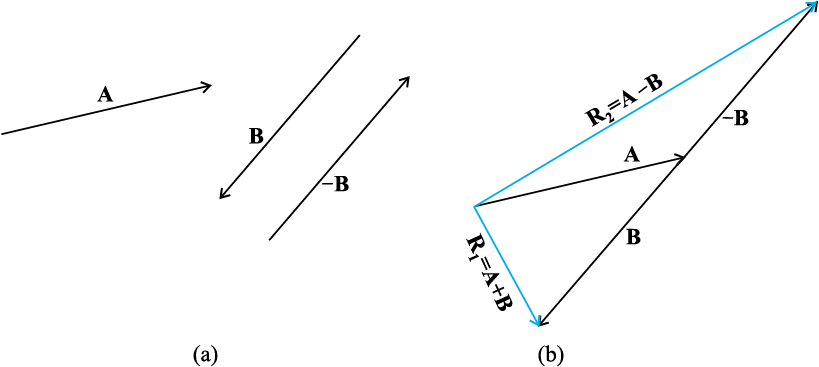
Fig. 4.5 (a) Two vectors A and B, – B is also shown. (b) Subtracting vector B from vector A – the result is R2. For comparison, addition of vectors A and B, i.e. R1 is also shown.

Fig. 4.6 (a) Two vectors A and B with their tails brought to a common origin. (b) The sum A+ B obtained using the parallelogram method. (c) The parallelogram method of vector addition is equivalent to the triangle method.
Example 4.1 Rain is falling vertically with a speed of 35 m s–1. Winds starts blowing after sometime with a speed of 12 m s–1 in east to west direction. In which direction should a boy waiting at a bus stop hold his umbrella ?
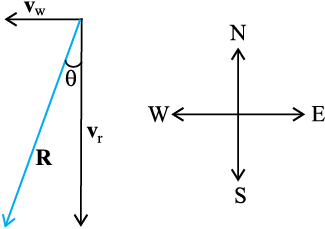
Fig. 4.7
Answer The velocity of the rain and the wind are represented by the vectors vr and vw in Fig. 4.7 and are in the direction specified by the problem. Using the rule of vector addition, we see that the resultant of vr and vw is R as shown in the figure. The magnitude of R is

The direction θ that R makes with the vertical is given by

Or, 
Therefore, the boy should hold his umbrella in the vertical plane at an angle of about 19o with the vertical towards the east.
Let a and b be any two non-zero vectors in a plane with different directions and let A be another vector in the same plane(Fig. 4.8). A can be expressed as a sum of two vectors — one obtained by multiplying a by a real number and the other obtained by multiplying b by another real number. To see this, let O and P be the tail and head of the vector A. Then, through O, draw a straight line parallel to a, and through P, a straight line parallel to b. Let them intersect at Q. Then, we have
A = OP = OQ + QP (4.6)
But since OQ is parallel to a, and QP is parallel to b, we can write :
OQ = λ a, and QP = µ b (4.7)
where λ and µ are real numbers.
Therefore, A = λ a + µ b (4.8)
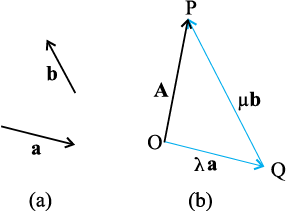
Fig. 4.8 (a) Two non-colinear vectors a and b. (b) Resolving a vector A in terms of vectors a and b.
We say that A has been resolved into two component vectors λ a and µ b along a and b respectively. Using this method one can resolve a given vector into two component vectors along a set of two vectors – all the three lie in the same plane. It is convenient to resolve a general vector along the axes of a rectangular coordinate system using vectors of unit magnitude. These are called unit vectors that we discuss now. A unit vector is a vector of unit magnitude and points in a particular direction. It has no dimension and unit. It is used to specify a direction only. Unit vectors along the x-, y- and z-axes of a rectangular coordinate system are denoted by

and , respectively, as shown in Fig. 4.9(a).
, respectively, as shown in Fig. 4.9(a).
Since these are unit vectors, we have

(4.9)
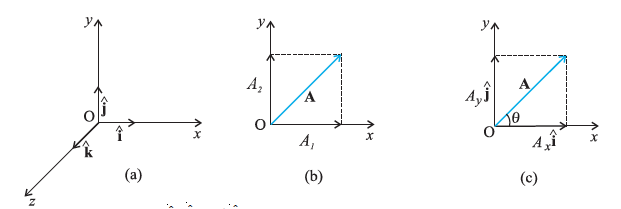
Fig. 4.9 (a) Unit vectors î, ĵ and  lie along the x-, y-, and z-axes. (b) A vector A is resolved into its components Ax and Ay along x-, and y- axes. (c) A1 and A2 expressed in terms of î and ĵ .
lie along the x-, y-, and z-axes. (b) A vector A is resolved into its components Ax and Ay along x-, and y- axes. (c) A1 and A2 expressed in terms of î and ĵ .
These unit vectors are perpendicular to each other. In this text, they are printed in bold face with a cap (^) to distinguish them from other vectors. Since we are dealing with motion in two dimensions in this chapter, we require use of only two unit vectors. If we multiply a unit vector, say  by a scalar, the result is a vector
by a scalar, the result is a vector

. In general, a vector A can be written as
(4.10)
where  is a unit vector along A.
is a unit vector along A.
We can now resolve a vector A in terms of component vectors that lie along unit vectors  and
and
 Consider a vector A that lies in x-y plane as shown in Fig. 4.9(b). We draw lines from the head of A perpendicular to the coordinate axes as in Fig. 4.9(b), and get vectors A1 and A2 such that A1 + A2 = A. Since A1 is parallel to
Consider a vector A that lies in x-y plane as shown in Fig. 4.9(b). We draw lines from the head of A perpendicular to the coordinate axes as in Fig. 4.9(b), and get vectors A1 and A2 such that A1 + A2 = A. Since A1 is parallel to

and A2 is parallel to

, we have :

(4.11)
where Ax and Ay are real numbers.

(4.12)
This is represented in Fig. 4.9(c). The quantities Ax and Ay are called x-, and y- components of the vector A. Note that Ax is itself not a vector, but

is a vector, and so is
. Using simple trigonometry, we can express Ax and Ay in terms of the magnitude of A and the angle θ it makes with the x-axis :
Ax = A cos θ
Ay = A sin θ (4.13)
As is clear from Eq. (4.13), a component of a vector can be positive, negative or zero depending on the value of θ.
Now, we have two ways to specify a vector A in a plane. It can be specified by :
(i) its magnitude A and the direction θ it makes with the x-axis; or
(ii) its components Ax and Ay
If A and θ are given, Ax and Ay can be obtained using Eq. (4.13). If Ax and Ay are given, A and θ can be obtained as follows :

= A2
Or, 
And
So far we have considered a vector lying in an x-y plane. The same procedure can be used to resolve a general vector A into three components along x-, y-, and z-axes in three dimensions. If α, β, and γ are the angles* between A and the x-, y-, and z-axes, respectively [Fig. 4.9(d)], we have
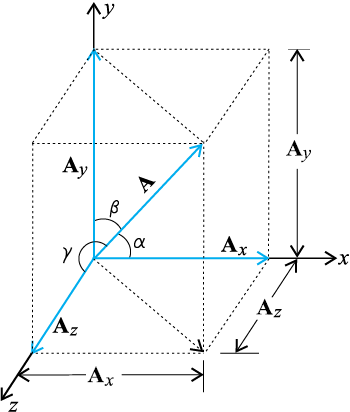
(d)
Fig. 4.9 (d) A vector A resolved into components along x-, y-, and z-axes

In general, we have

The magnitude of vector A is

A position vector r can be expressed as

(4.17)
where x, y, and z are the components of r along x-, y-, z-axes, respectively.
Although the graphical method of adding vectors helps us in visualising the vectors and the resultant vector, it is sometimes tedious and has limited accuracy. It is much easier to add vectors by combining their respective components. Consider two vectors A and B in x-y plane with components Ax, Ay and Bx, By :

(4.18)

Let R be their sum. We have
R = A + B

(4.19a)
Since vectors obey the commutative and associative laws, we can arrange and regroup the vectors in Eq. (4.19a) as convenient to us :

Since

we have, 
Thus, each component of the resultant vector R is the sum of the corresponding components of A and B.
In three dimensions, we have

with 


This method can be extended to addition and subtraction of any number of vectors. For example, if vectors a, b and c are given as

(4.23a)
then, a vector T = a + b – c has components :



* Note that angles α, β, and γ are angles in space. They are between pairs of lines, which are not coplanar.
Example 4.2 Find the magnitude and direction of the resultant of two vectors A and B in terms of their magnitudes and angle θ between them.
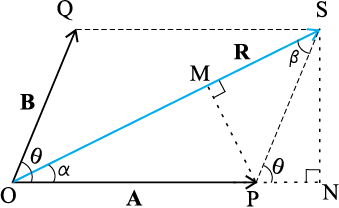
Fig. 4.10
Answer Let OP and OQ represent the two vectors A and B making an angle θ (Fig. 4.10). Then, using the parallelogram method of vector addition, OS represents the resultant vector R :
R = A + B
SN is normal to OP and PM is normal to OS.
From the geometry of the figure,
OS2 = ON2 + SN2
but ON = OP + PN = A + B cos θ SN = B sin θ
OS2 = (A + B cos θ)2 + (B sin θ)2
or, R2 = A2 + B2 + 2AB cos θ

In ∆ OSN, SN = OS sinα = R sinα, and in ∆ PSN, SN = PS sin θ = B sin θ
Therefore, R sin α = B sin θ
or, 
Similarly,
PM = A sin α = B sin β
or, 
Combining Eqs. (4.24b) and (4.24c), we get

Using Eq. (4.24d), we get:

where R is given by Eq. (4.24a).
or, 
Equation (4.24a) gives the magnitude of the resultant and Eqs. (4.24e) and (4.24f) its direction. Equation (4.24a) is known as the Law of cosines and Eq. (4.24d) as the Law of sines.
Example 4.3 A motorboat is racing towards north at 25 km/h and the water current in that region is 10 km/h in the direction of 60° east of south. Find the resultant velocity of the boat.
Answer The vector vb representing the velocity of the motorboat and the vector vc representing the water current are shown in Fig. 4.11 in directions specified by the problem. Using the parallelogram method of addition, the resultant R is obtained in the direction shown in the figure.
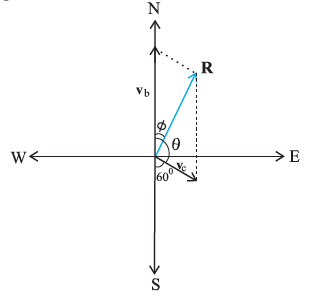
We can obtain the magnitude of R using the Law of cosine :


To obtain the direction, we apply the Law of sines 
or, 


In this section we shall see how to describe motion in two dimensions using vectors.
The position vector r of a particle P located in a plane with reference to the origin of an x-y reference frame (Fig. 4.12) is given by

where x and y are components of r along x-, and y- axes or simply they are the coordinates of the object.
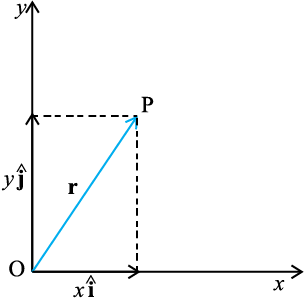
(a)
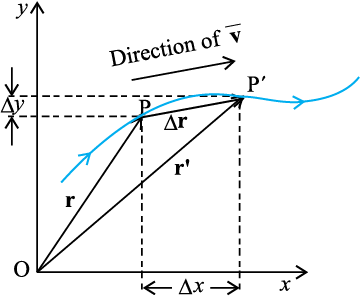
(b)
Fig. 4.12 (a) Position vector r. (b) Displacement ∆r and average velocity v of a particle.
Suppose a particle moves along the curve shown by the thick line and is at P at time t and P′ at time t′ [Fig. 4.12(b)]. Then, the displacement is :
∆r = r′ – r (4.25)
and is directed from P to P′.
We can write Eq. (4.25) in a component form:

where ∆x = x ′ – x, ∆y = y′ – y (4.26)
The average velocity  of an object is the ratio of the displacement and the corresponding time interval :
of an object is the ratio of the displacement and the corresponding time interval :


Since
, the direction of the average velocity is the same as that of ∆r (Fig. 4.12). The velocity(instantaneous velocity) is given by the limiting value of the average velocity as the time interval approaches zero :

(4.28)

Fig. 4.13 As the time interval ∆t approaches zero, the average velocity approaches the velocity v. The direction of is parallel to the line tangent to the path.
is parallel to the line tangent to the path.
The meaning of the limiting process can be easily understood with the help of Fig 4.13(a) to (d). In these figures, the thick line represents the path of an object, which is at P at time t. P1, P2 and P3 represent the positions of the object after times ∆t1,∆t2, and ∆t3. ∆r1, ∆r2, and ∆r3 are the displacements of the object in times ∆t1, ∆t2, and ∆t3, respectively. The direction of the average velocity

is shown in figures (a), (b) and (c) for three decreasing values of ∆t, i.e. ∆t1,∆t2, and ∆t3, (∆t1 > ∆t2 > ∆t3). As ∆t → 0, ∆r → 0 and is along the tangent to the path [Fig. 4.13(d)]. Therefore, the direction of velocity at any point on the path of an object is tangential to the path at that point and is in the direction of motion.
We can express v in a component form :


(4.29)

Or,

. where

So, if the expressions for the coordinates x and y are known as functions of time, we can use these equations to find vx and vy.
The magnitude of v is then

(4.30b)
and the direction of v is given by the angle θ :

(4.30c)
vx, vy and angle θ are shown in Fig. 4.14 for a velocity vector v at point p.
The average acceleration a of an object for a time interval ∆t moving in x-y plane is the change in velocity divided by the time interval :

(4.31a)
Or,

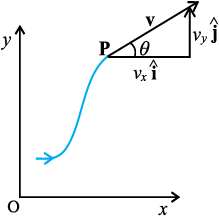
Fig. 4.14 The components vx and vy of velocity v and the angle θ it makes with x-axis. Note that vx = v cos θ, vy = v sin θ.
The acceleration (instantaneous acceleration) is the limiting value of the average acceleration as the time interval approaches zero :

(4.32a)
Since

we have

Or,

(4.32b)
where,

(4.32c)*
As in the case of velocity, we can understand graphically the limiting process used in defining acceleration on a graph showing the path of the object’s motion. This is shown in Figs. 4.15(a) to (d). P represents the position of the object at time t and P1, P2, P3 positions after time ∆t1, ∆t2, ∆t3, respectively (∆t1> ∆t2>∆t3). The velocity vectors at points P, P1, P2, P3 are also shown in Figs. 4.15 (a), (b) and (c). In each case of ∆t, ∆v is obtained using the triangle law of vector addition. By definition, the direction of average acceleration is the same as that of ∆v. We see that as ∆t decreases, the direction of ∆v changes and consequently, the direction of the acceleration changes. Finally, in the limit ∆t g0 [Fig. 4.15(d)], the average acceleration becomes the instantaneous acceleration and has the direction as shown.
* In terms of x and y, ax and ay can be expressed as

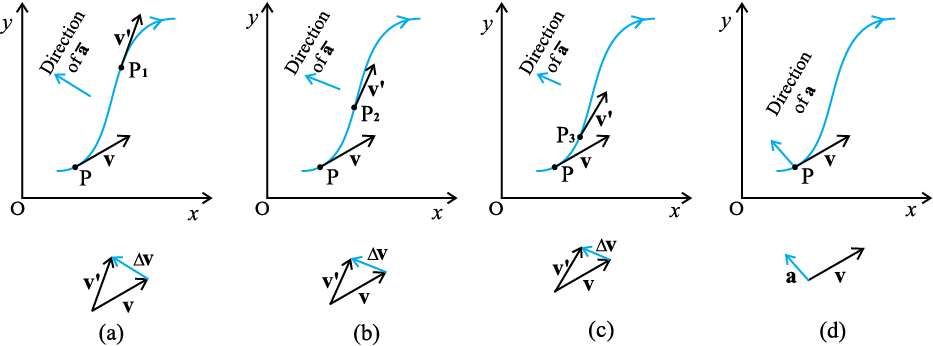
Note that in one dimension, the velocity and the acceleration of an object are always along the same straight line (either in the same direction or in the opposite direction). However, for motion in two or three dimensions, velocity and acceleration vectors may have any angle between 0° and 180° between them.
Example 4.4 The position of a particle is given by

where t is in seconds and the coefficients have the proper units for r to be in meters. (a) Find v(t) and a(t) of the particle. (b) Find the magnitude and direction of v(t) at
t = 1.0 s.
Answer



a = 4.0 m s–2 along y-direction
At t = 1.0 s,

It’s magnitude is

and direction is

with x-axis.
Suppose that an object is moving in x-y plane and its acceleration a is constant. Over an interval of time, the average acceleration will equal this constant value. Now, let the velocity of the object be v0 at time t = 0 and v at time t.
Then, by definition

Or,

(4.33a)
In terms of components :

(4.33b)
Let us now find how the position r changes with time. We follow the method used in the one-dimensional case. Let ro and r be the position vectors of the particle at time 0 and t and let the velocities at these instants be vo and v. Then, over this time interval t, the average velocity is (vo + v)/2. The displacement is the average velocity multiplied by the time interval :



(4.34a)
Or,
It can be easily verified that the derivative of Eq. (4.34a), i.e.

gives Eq.(4.33a) and it also satisfies the condition that at t=0, r = ro. Equation (4.34a) can be written in component form as

(4.34b)
One immediate interpretation of Eq.(4.34b) is that the motions in x- and y-directions can be treated independently of each other. That is, motion in a plane (two-dimensions) can be treated as two separate simultaneous one-dimensional motions with constant acceleration along two perpendicular directions. This is an important result and is useful in analysing motion of objects in two dimensions. A similar result holds for three dimensions. The choice of perpendicular directions is convenient in many physical situations, as we shall see in section 4.10 for projectile motion.
Example 4.5 A particle starts from origin at t = 0 with a velocity 5.0 î m/s and moves in x-y plane under action of a force which produces a constant acceleration of (3.0 î +2.0 ĵ ) m/s2. (a) What is the y-coordinate of the particle at the instant its x-coordinate is 84 m ? (b) What is the speed of the particle at this time ?
Answer From Eq. (4.34a) for r0 = 0, the position of the particle is given by



Therefore,


Given x (t) = 84 m, t = ?
5.0 t + 1.5 t2 = 84 ⇒ t = 6 s
At t = 6 s, y = 1.0 (6)2 = 36.0 m

At t = 6 s,
v = 23.0 î +12.0 ĵ
speed
.
The concept of relative velocity, introduced in section 3.7 for motion along a straight line, can be easily extended to include motion in a plane or in three dimensions. Suppose that two objects A and B are moving with velocities vA and vB (each with respect to some common frame of reference, say ground
.). Then, velocity of object A relative to that of B is :
vAB = vA – vB (4.35a)
and similarly, the velocity of object B relative to that of A is :
vBA = vB – vA
Therefore, vAB = – vBA (4.35b)
and,

Example 4.6 Rain is falling vertically with a speed of 35 m s–1. A woman rides a bicycle with a speed of 12 m s–1 in east to west direction. What is the direction in which she should hold her umbrella ?
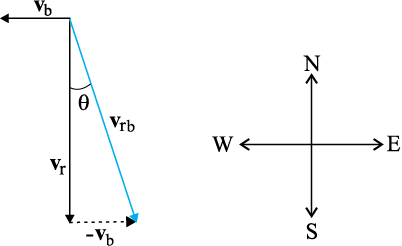


Therefore, the woman should hold her umbrella at an angle of about 19° with the vertical towards the west.
Note carefully the difference between this Example and the Example 4.1. In Example 4.1, the boy experiences the resultant (vector sum) of two velocities while in this example, the woman experiences the velocity of rain relative to the bicycle (the vector difference of the two velocities).
As an application of the ideas developed in the previous sections, we consider the motion of a projectile. An object that is in flight after being thrown or projected is called a projectile. Such a projectile might be a football, a cricket ball, a baseball or any other object. The motion of a projectile may be thought of as the result of two separate, simultaneously occurring components of motions. One component is along a horizontal direction without any acceleration and the other along the vertical direction with constant acceleration due to the force of gravity. It was Galileo who first stated this independency of the horizontal and the vertical components of projectile motion in his Dialogue on the great world systems (1632).
In our discussion, we shall assume that the air resistance has negligible effect on the motion of the projectile. Suppose that the projectile is launched with velocity vo that makes an angle θo with the x-axis as shown in Fig. 4.17.
After the object has been projected, the acceleration acting on it is that due to gravity which is directed vertically downward:
a = -g ĵ
Or, ax = 0, ay = – g (4.36)
The components of initial velocity vo are :
vox = vo cos θo
voy= vo sin θo (4.37)
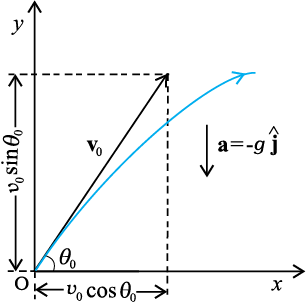
Fig 4.17 Motion of an object projected with velocity vo at angle θ0.
If we take the initial position to be the origin of the reference frame as shown in Fig. 4.17, we have :
xo = 0, yo = 0
Then, Eq.(4.34b) becomes :
x = vox t = (vo cos θo ) t and y = (vo sin θo ) t – ( ½ )g t2 (4.38)
The components of velocity at time t can be obtained using Eq.(4.33b) :
vx = vox = vo cos θo
vy = vo sin θo – g t (4.39)
Equation (4.38) gives the x-, and y-coordinates of the position of a projectile at time t in terms of two parameters — initial speed vo and projection angle θo. Notice that the choice of mutually perpendicular x-, and y-directions for the analysis of the projectile motion has resulted in a simplification.
One of the components of velocity, i.e. x-component remains constant throughout the motion and only the y- component changes, like an object in free fall in vertical direction. This is shown graphically at few instants in Fig. 4.18. Note that at the point of maximum height, vy= 0 and therefore,

Equation of path of a projectile
What is the shape of the path followed by the projectile? This can be seen by eliminating the time between the expressions for x and y as given in Eq. (4.38). We obtain:

Now, since g, θo and vo are constants, Eq. (4.40) is of the form y = a x + b x2, in which a and b are constants. This is the equation of a parabola, i.e. the path of the projectile is a parabola (Fig. 4.18).
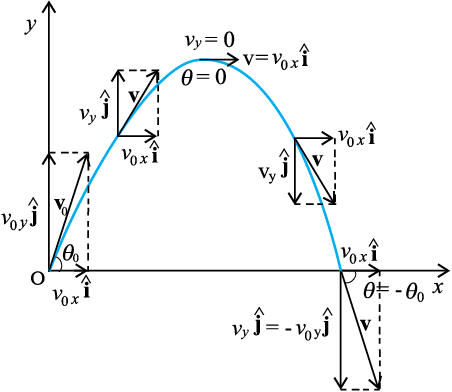
Fig. 4.18 The path of a projectile is a parabola.
Time of maximum height
How much time does the projectile take to reach the maximum height ? Let this time be denoted by tm. Since at this point, vy= 0, we have from Eq. (4.39):
vy = vo sinθo – g tm = 0
Or, tm = vo sinθo /g (4.41a)
The total time Tf during which the projectile is in flight can be obtained by putting y = 0 in Eq. (4.38). We get :
Tf = 2 (vo sin θo )/g (4.41b)
Tf is known as the time of flight of the projectile. We note that Tf = 2 tm , which is expected because of the symmetry of the parabolic path.
Maximum height of a projectile
The maximum height hm reached by the
projectile can be calculated by substituting t = tm in Eq. (4.38) :


(4.42)
Horizontal range of a projectile
The horizontal distance travelled by a projectile from its initial position (x = y = 0) to the position where it passes y = 0 during its fall is called the horizontal range, R. It is the distance travelled during the time of flight Tf . Therefore, the range R is
R = (vo cos θo) (Tf )
=(vo cos θo) (2 vo sin θo)/g
Or,

(4.43a)
Equation (4.43a) shows that for a given projection velocity vo , R is maximum when sin 2θ0is maximum, i.e., when θ0 = 450.
The maximum horizontal range is, therefore,

(4.43b)
Example 4.7 Galileo, in his book Two new sciences, stated that “for elevations which exceed or fall short of 45° by equal amounts, the ranges are equal”. Prove this statement.
Answer For a projectile launched with velocity vo at an angle θo , the range is given by

Now, for angles, (45° + α) and ( 45° – α), 2θo is (90° + 2α) and ( 90° – 2α) , respectively. The values of sin (90° + 2α) and sin (90° – 2α) are the same, equal to that of cos 2α. Therefore, ranges are equal for elevations which exceed or fall short of 45° by equal amounts α.
Example 4.8 A hiker stands on the edge of a cliff 490 m above the ground and throws a stone horizontally with an initial speed of 15 m s-1. Neglecting air resistance, find the time taken by the stone to reach the ground, and the speed with which it hits the ground. (Take g = 9.8 m s-2 ).
Answer We choose the origin of the x-,and y-axis at the edge of the cliff and t = 0 s at the instant the stone is thrown. Choose the positive direction of x-axis to be along the initial velocity and the positive direction of y-axis to be the vertically upward direction. The x-, and y- components of the motion can be treated independently. The equations of motion are :
x (t) = xo + vox t
y (t) = yo + voy t +(1/2) ay t2
Here, xo = yo = 0, voy = 0, ay = –g = –9.8 m s-2,
vox = 15 m s-1.
The stone hits the ground when y(t) = – 490 m.
– 490 m = –(1/2)(9.8) t2.
This gives t =10 s.
The velocity components are vx = vox and vy = voy – g t
so that when the stone hits the ground :
vox = 15 m s–1
voy = 0 – 9.8 × 10 = – 98 m s–1
Therefore, the speed of the stone is

Example 4.9 A cricket ball is thrown at a speed of 28 m s–1 in a direction 30° above the horizontal. Calculate (a) the maximum height, (b) the time taken by the ball to return to the same level, and (c) the distance from the thrower to the point where the ball returns to the same level.
Answer (a) The maximum height is given by


(b) The time taken to return to the same level is
Tf = (2 vo sin θo )/g = (2× 28 × sin 30° )/9.8 = 28/9.8 s = 2.9 s
(c) The distance from the thrower to the point where the ball returns to the same level is
R

While treating the topic of projectile motion, we have stated that we assume that the air resistance has no effect on the motion of the projectile. You must understand what the statement really means. Friction, force due to viscosity, air resistance are all dissipative forces. In the presence of any of such forces opposing motion, any object will lose some part of its initial energy and consequently, momentum too. Thus, a projectile that traverses a parabolic path would certainly show deviation from its idealised trajectory in the presence of air resistance. It will not hit the ground with the same speed with which it was projected from it. In the absence of air resistance, the x-component of the velocity remains constant and it is only the y-component that undergoes a continuous change. However, in the presence of air resistance, both of these would get affected. That would mean that the range would be less than the one given by Eq. (4.43). Maximum height attained would also be less than that predicted by Eq. (4.42). Can you then, anticipate the change in the time of flight?
In order to avoid air resistance, we will have to perform the experiment in vacuum or under low pressure, which is not easy. When we use a phrase like ‘neglect air resistance’, we imply that the change in parameters such as range, height etc. is much smaller than their values without air resistance. The calculation without air resistance is much simpler than that with air resistance.
When an object follows a circular path at a constant speed, the motion of the object is called uniform circular motion. The word “uniform” refers to the speed, which is uniform (constant) throughout the motion. Suppose an object is moving with uniform speed v in a circle of radius R as shown in Fig. 4.19. Since the velocity of the object is changing continuously in direction, the object undergoes acceleration. Let us find the magnitude and the direction of this acceleration.

Fig. 4.19 Velocity and acceleration of an object in uniform circular motion. The time interval ∆t decreases from (a) to (c) where it is zero. The acceleration is directed, at each point of the path, towards the centre of the circle.
Let r and r′ be the position vectors and v and v′ the velocities of the object when it is at point P and P′ as shown in Fig. 4.19(a). By definition, velocity at a point is along the tangent at that point in the direction of motion. The velocity vectors v and v′ are as shown in Fig. 4.19(a1). ∆v is obtained in Fig. 4.19 (a2) using the triangle law of vector addition. Since the path is circular, v is perpendicular to r and so is v′ to r′. Therefore, ∆v is perpendicular to ∆r. Since average acceleration is along ∆v
 , the average acceleration
, the average acceleration  is perpendicular to ∆r. If we place ∆v on the line that bisects the angle between r and r′, we see that it is directed towards the centre of the circle. Figure 4.19(b) shows the same quantities for smaller time interval. ∆v and hence
is perpendicular to ∆r. If we place ∆v on the line that bisects the angle between r and r′, we see that it is directed towards the centre of the circle. Figure 4.19(b) shows the same quantities for smaller time interval. ∆v and hence
 is again directed towards the centre. In Fig. 4.19(c), ∆t→0 and the average acceleration becomes the instantaneous acceleration. It is directed towards the centre*. Thus, we find that the acceleration of an object in uniform circular motion is always directed towards the centre of the circle. Let us now find the magnitude of the acceleration.
is again directed towards the centre. In Fig. 4.19(c), ∆t→0 and the average acceleration becomes the instantaneous acceleration. It is directed towards the centre*. Thus, we find that the acceleration of an object in uniform circular motion is always directed towards the centre of the circle. Let us now find the magnitude of the acceleration.
The magnitude of a is, by definition, given by

* In the limit ∆t→0, ∆r becomes perpendicular to r. In this limit ∆v→ 0 and is consequently also perpendicular to V. Therefore, the acceleration is directed towards the centre, at each point of the circular path.
Let the angle between position vectors r and r′ be ∆θ. Since the velocity vectors v and v′ are always perpendicular to the position vectors, the angle between them is also ∆θ . Therefore, the triangle CPP′ formed by the position vectors and the triangle GHI formed by the velocity vectors v, v′ and ∆v are similar (Fig. 4.19a). Therefore, the ratio of the base-length to side-length for one of the triangles is equal to that of the other triangle. That is :

Or,

Therefore,

If ∆t is small, ∆θ will also be small and then arc PP′ can be approximately taken to be|∆r|:


Or,

Therefore, the centripetal acceleration ac is :

Thus, the acceleration of an object moving with speed v in a circle of radius R has a magnitude v2/R and is always directed towards the centre. This is why this acceleration is called centripetal acceleration (a term proposed by Newton). A thorough analysis of centripetal acceleration was first published in 1673 by the Dutch scientist Christiaan Huygens (1629-1695) but it was probably known to Newton also some years earlier. “Centripetal” comes from a Greek term which means ‘centre-seeking’. Since v and R are constant, the magnitude of the centripetal acceleration is also constant. However, the direction changes — pointing always towards the centre. Therefore, a centripetal acceleration is not a constant vector.
We have another way of describing the velocity and the acceleration of an object in uniform circular motion. As the object moves from P to P′ in time ∆t (= t′ – t), the line CP (Fig. 4.19) turns through an angle ∆θ as shown in the figure. ∆θ is called angular distance. We define the angular speed ω (Greek letter omega) as the time rate of change of angular displacement :

(4.45)
Now, if the distance travelled by the object during the time ∆t is ∆s, i.e. PP′ is ∆s, then :

but ∆s = R ∆θ. Therefore :

v = R ω (4.46)
We can express centripetal acceleration ac in terms of angular speed :


The time taken by an object to make one revolution is known as its time period T and the number of revolution made in one second is called its frequency ν (=1/T). However, during this time the distance moved by the object is s = 2πR.
Therefore, v = 2πR/T =2πRν (4.48)
In terms of frequency ν, we have
ω = 2πν
v = 2πRν
ac = 4π2 ν2R (4.49)
Example 4.10 An insect trapped in a circular groove of radius 12 cm moves along the groove steadily and completes 7 revolutions in 100 s. (a) What is the angular speed, and the linear speed of the motion? (b) Is the acceleration vector a constant vector ? What is its magnitude ?
Answer This is an example of uniform circular motion. Here R = 12 cm. The angular speed ω is given by
ω = 2π/T = 2π × 7/100 = 0.44 rad/s
The linear speed v is :
v =ω R = 0.44 s-1 × 12 cm = 5.3 cm s-1
The direction of velocity v is along the tangent to the circle at every point. The acceleration is directed towards the centre of the circle. Since this direction changes continuously, acceleration here is not a constant vector. However, the magnitude of acceleration is constant:
a = ω2 R = (0.44 s–1)2 (12 cm)
= 2.3 cm s-2
1. Scalar quantities are quantities with magnitudes only. Examples are distance, speed, mass and temperature.
2. Vector quantities are quantities with magnitude and direction both. Examples are displacement, velocity and acceleration. They obey special rules of vector algebra.
3. A vector A multiplied by a real number λ is also a vector, whose magnitude is λ times the magnitude of the vector A and whose direction is the same or opposite depending upon whether λ is positive or negative.
4. Two vectors A and B may be added graphically using head-to-tail method or parallelogram method.
5. Vector addition is commutative :
A + B = B + A
It also obeys the associative law :
(A + B) + C = A + (B + C)
6. A null or zero vector is a vector with zero magnitude. Since the magnitude is zero, we don’t have to specify its direction. It has the properties :
A + 0 = A
λ0 = 0
0 A = 0
7. The subtraction of vector B from A is defined as the sum of A and –B :
A – B = A+ (–B)
8. A vector A can be resolved into component along two given vectors a and b lying in the same plane :
A = λ a + µ b
where λ and µ are real numbers.
9. A unit vector associated with a vector A has magnitude 1 and is along the vector A:

The unit vectors  are vectors of unit magnitude and point in the direction of the x-, y-, and z-axes, respectively in a right-handed coordinate system.
are vectors of unit magnitude and point in the direction of the x-, y-, and z-axes, respectively in a right-handed coordinate system.
10. A vector A can be expressed as

where Ax, Ay are its components along x-, and y -axes. If vector A makes an angle θ with the x-axis, then Ax = A cos θ, Ay=A sin θ and

11. Vectors can be conveniently added using analytical method. If sum of two vectors A and B, that lie in x-y plane, is R, then :
 12. The position vector of an object in x-y plane is given by
12. The position vector of an object in x-y plane is given by
 and the displacement from position r to position r’ is given by
and the displacement from position r to position r’ is given by
∆r = r′− r

13. If an object undergoes a displacement ∆r in time ∆t, its average velocity is given by
v =  . The velocity of an object at time t is the limiting value of the average velocity as ∆t tends to zero :
. The velocity of an object at time t is the limiting value of the average velocity as ∆t tends to zero :

. It can be written in unit vector notation as :
 where
where 
When position of an object is plotted on a coordinate system, v is always tangent to the curve representing the path of the object.
14. If the velocity of an object changes from v to v′in time ∆t, then its average acceleration is given by:

The acceleration a at any time t is the limiting value of as ∆t →0 :
as ∆t →0 :

In component form, we have :

where,
15. If an object is moving in a plane with constant acceleration
 and its position vector at time t = 0 is ro, then at any other time t, it will be at a point given by:
and its position vector at time t = 0 is ro, then at any other time t, it will be at a point given by:

and its velocity is given by :
v = vo + a t
where vo is the velocity at time t = 0
In component form :




Motion in a plane can be treated as superposition of two separate simultaneous one-dimensional motions along two perpendicular directions
16. An object that is in flight after being projected is called a projectile. If an object is projected with initial velocity vo making an angle θo with x-axis and if we assume its initial position to coincide with the origin of the coordinate system, then the position and velocity of the projectile at time t are given by :
x = (vo cos θo) t
y = (vo sin θo) t − (1/2) g t2
vx = vox = vo cos θo
vy = vo sin θo − g t
The path of a projectile is parabolic and is given by :

The maximum height that a projectile attains is :
The time taken to reach this height is :
 The horizontal distance travelled by a projectile from its initial position to the position it passes y = 0 during its fall is called the range, R of the projectile. It is :
The horizontal distance travelled by a projectile from its initial position to the position it passes y = 0 during its fall is called the range, R of the projectile. It is :
17. When an object follows a circular path at constant speed, the motion of the object is called uniform circular motion. The magnitude of its acceleration is ac = v2 /R. The direction of ac is always towards the centre of the circle.
The angular speed ω, is the rate of change of angular distance. It is related to velocity v by v = ω R. The acceleration is ac = ω 2R.
If T is the time period of revolution of the object in circular motion and ν is its frequency, we have ω = 2π ν, v = 2πνR, ac = 4π2ν2R
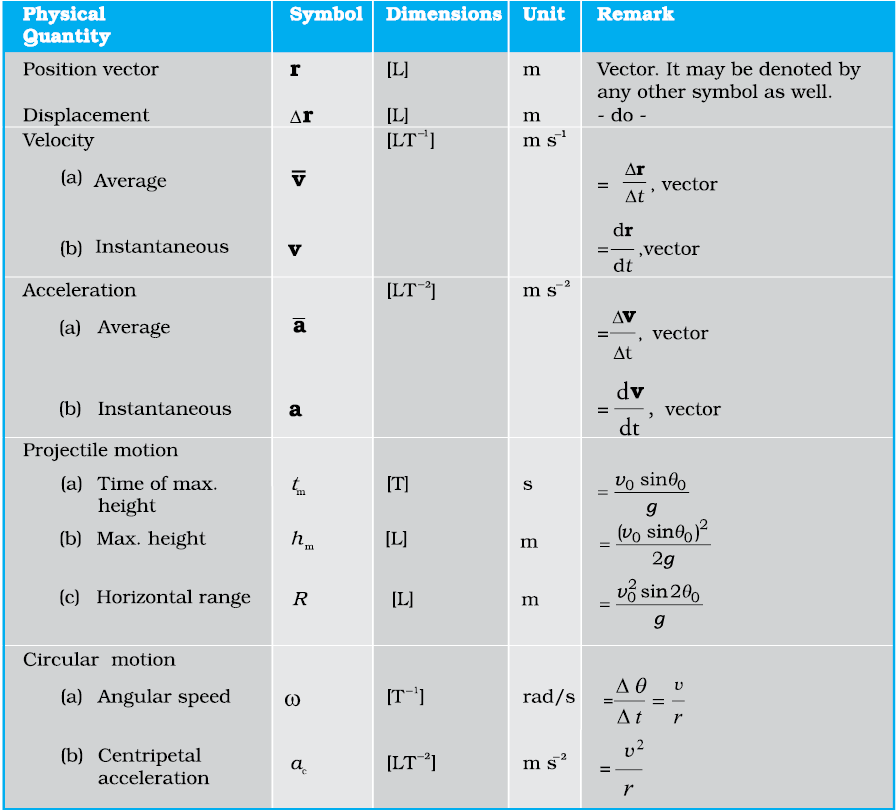
1. The path length traversed by an object between two points is, in general, not the same as the magnitude of displacement. The displacement depends only on the end points; the path length (as the name implies) depends on the actual path. The two quantities are equal only if the object does not change its direction during the course of motion. In all other cases, the path length is greater than the magnitude of displacement.
2. In view of point 1 above, the average speed of an object is greater than or equal to the magnitude of the average velocity over a given time interval. The two are equal only if the path length is equal to the magnitude of displacement.
3. The vector equations (4.33a) and (4.34a) do not involve any choice of axes. Of course, you can always resolve them along any two independent axes.
4. The kinematic equations for uniform acceleration do not apply to the case of uniform circular motion since in this case the magnitude of acceleration is constant but its direction is changing.
5. An object subjected to two velocities v1 and v2 has a resultant velocity v = v1 + v2. Take care to distinguish it from velocity of object 1 relative to velocity of object 2 : v12= v1 − v2. Here v1 and v2 are velocities with reference to some common reference frame.
6. The resultant acceleration of an object in circular motion is towards the centre only if the speed is constant.
7. The shape of the trajectory of the motion of an object is not determined by the acceleration alone but also depends on the initial conditions of motion ( initial position and initial velocity). For example, the trajectory of an object moving under the same acceleration due to gravity can be a straight line or a parabola depending on the initial conditions.
Question 4.1: State, for each of the following physical quantities, if it is a scalar or a vector: volume, mass, speed, acceleration, density, number of moles, velocity, angular frequency, displacement, angular velocity.
NEETprep Answer4.2 Pick out the two scalar quantities in the following list :
force, angular momentum, work, current, linear momentum, electric field, average velocity, magnetic moment, relative velocity.
NEETprep Answer4.3 Pick out the only vector quantity in the following list :
Temperature, pressure, impulse, time, power, total path length, energy, gravitational potential, coefficient of friction, charge.
NEETprep Answer4.4 State with reasons, whether the following algebraic operations with scalar and vector physical quantities are meaningful :
(a) adding any two scalars, (b) adding a scalar to a vector of the same dimensions, (c) multiplying any vector by any scalar, (d) multiplying any two scalars, (e) adding any two vectors, (f) adding a component of a vector to the same vector.
NEETprep Answer4.5 Read each statement below carefully and state with reasons if it is true or false :
(a) The magnitude of a vector is always a scalar, (b) each component of a vector is always a scalar, (c) the total path length is always equal to the magnitude of the displacement vector of a particle. (d) the average speed of a particle (defined as total path length divided by the time taken to cover the path) is either greater or equal to the magnitude of the average velocity of the particle over the same interval of time, (e) Three vectors not lying in a plane can never add up to give a null vector.
NEETprep Answer4.6 Establish the following vector inequalities geometrically or otherwise :
(a) |a+b| ≤ | a| + |b|
(b) |a+b| ≥ ||a| −|b||
(c) |a−b| ≤ |a| + |b|
(d) |a−b| ≥||a| − |b||
When does the equality sign above apply?
NEETprep Answer4.7 Given a + b + c + d = 0, which of the following statements are correct :
(a) a, b, c, and d must each be a null vector,
(b) The magnitude of (a + c) equals the magnitude of ( b + d),
(c) The magnitude of a can never be greater than the sum of the magnitudes of b, c, and d,
(d) b + c must lie in the plane of a and d if a and d are not collinear, and in the line of a and d, if they are collinear?
NEETprep Answer
4.8 Three girls skating on a circular ice ground of radius 200 m start from a point P on the edge of the ground and reach a point Q diametrically opposite to P following different paths as shown in Fig. 4.20. What is the magnitude of the displacement vector for each? For which girl is this equal to the actual length of path skate?
NEETprep Answer
4.9 A cyclist starts from the centre O of a circular park of radius 1 km, reaches the edge P of the park, then cycles along the circumference, and returns to the centre along QO as shown in Fig. 4.21. If the round trip takes 10 min, what is the (a) net displacement, (b) average velocity, and (c) average speed of the cyclist?

Fig. 4.21
NEETprep Answer4.10 On an open ground, a motorist follows a track that turns to his left by an angle of 600 after every 500 m. Starting from a given turn, specify the displacement of the motorist at the third, sixth, and eighth turn. Compare the magnitude of the displacement with the total path length covered by the motorist in each case.
NEETprep Answer
4.11 A passenger arriving in a new town wishes to go from the station to a hotel located 10 km away on a straight road from the station. A dishonest cabman takes him along a circuitous path 23 km long and reaches the hotel in 28 min. What is (a) the average speed of the taxi, (b) the magnitude of average velocity? Are the two equal?
NEETprep Answer
4.12 Rain is falling vertically with a speed of 30 m s-1. A woman rides a bicycle with a speed of 10 m s-1 in the north to south direction. What is the direction in which she should hold her umbrella?
NEETprep Answer
4.13 A man can swim with a speed of 4.0 km/h in still water. How long does he take to cross a river 1.0 km wide if the river flows steadily at 3.0 km/h and he makes his strokes normal to the river current? How far down the river does he go when he reaches the other bank?
NEETprep Answer
4.14 In a harbour, the wind is blowing at the speed of 72 km/h, and the flag on the mast of a boat anchored in the harbour flutters along the N-E direction. If the boat starts moving at a speed of 51 km/h to the north, what is the direction of the flag on the mast of the boat?
NEETprep Answer
4.15 The ceiling of a long hall is 25 m high. What is the maximum horizontal distance that a ball thrown with a speed of 40 m s-1 can go without hitting the ceiling of the hall?
NEETprep Answer
4.16 A cricketer can throw a ball to a maximum horizontal distance of 100 m. How much high above the ground can the cricketer throw the same ball?
NEETprep Answer
4.17 A stone tied to the end of a string 80 cm long is whirled in a horizontal circle at a constant speed. If the stone makes 14 revolutions in 25 s, what is the magnitude and direction of the acceleration of the stone?
NEETprep Answer
4.18 An aircraft executes a horizontal loop of radius 1.00 km with a steady speed of 900 km/h. Compare its centripetal acceleration with the acceleration due to gravity.
NEETprep Answer
4.19 Read each statement below carefully and state, with reasons, if it is true or false :
(a) The net acceleration of a particle in a circular motion is always along the radius of the circle towards the center
(b) The velocity vector of a particle at a point is always along the tangent to the path of the particle at that point
(c) The acceleration vector of a particle in uniform circular motion averaged over one cycle is a null vector
NEETprep Answer
4.20 The position of a particle is given by
NEETprep Answer
4.21 A particle starts from the origin at t = 0 s with a velocity of 10.0. m/s and moves in the x-y plane with a constant acceleration of
m s-2. (a) At what time is the x- coordinate of the particle 16 m? What is the y-coordinate of the particle at that time? (b) What is the speed of the particle at the time?
NEETprep Answer
4.22 are unit vectors along x- and y- axis respectively. What is the magnitude and direction of the vectors
, and? What are the components of a vector
along the directions of and
? [You may use graphical method]
NEETprep Answer
4.23 For any arbitrary motion in space, which of the following relations are true :
(a) vaverage = (1/2) (v (t1) + v (t2))
(b) vaverage = [r(t2) - r(t1) ] /(t2 – t1)
(c) v (t) = v (0) + a t
(d) r (t) = r (0) + v (0) t + (1/2) at2
(e) a average =[ v (t2) - v (t1 )] /( t2 – t1)
(The ‘average’ stands for average of the quantity over the time interval t1 to t2)
NEETprep Answer
4.24 Read each statement below carefully and state, with reasons and examples, if it is true or false :
A scalar quantity is one that
(a) is conserved in a process
(b) can never take negative values
(c) must be dimensionless
(d) does not vary from one point to another in space
(e) has the same value for observers with different orientations of axes.
NEETprep Answer
4.25 An aircraft is flying at a height of 3400 m above the ground. If the angle subtended at a ground observation point by the aircraft positions 10.0 s apart is 30°, what is the speed of the aircraft?
NEETprep Answer
4.26 A vector has magnitude and direction. Does it have a location in space? Can it vary with time? Will two equal vectors a and b at different locations in space necessarily have identical physical effects? Give examples in support of your answer.
NEETprep Answer
4.27 A vector has both magnitude and direction. Does it mean that anything that has magnitude and direction is necessarily a vector? The rotation of a body can be specified by the direction of the axis of rotation, and the angle of rotation about the axis. Does that make any rotation a vector?
NEETprep Answer
4.28 Can you associate vectors with (a) the length of a wire bent into a loop, (b) a plane area, (c) a sphere? Explain.
NEETprep Answer
4.29 A bullet fired at an angle of 30° with the horizontal hits the ground 3.0 km away. By adjusting its angle of projection, can one hope to hit a target 5.0 km away? Assume the muzzle speed to be fixed, and neglect air resistance.
NEETprep Answer
4.30 A fighter plane flying horizontally at an altitude of 1.5 km with a speed 720 km/h passes directly overhead an anti-aircraft gun. At what angle from the vertical should the gun be fired for the shell with muzzle speed 600 m s-1 to hit the plane? At what minimum altitude should the pilot fly the plane to avoid being hit? (Take g = 10 m s-2 ).
4.31 A cyclist is riding with a speed of 27 km/h. As he approaches a circular turn on the road of radius 80 m, he applies brakes and reduces his speed at the constant rate of 0.50 m/s every second. What is the magnitude and direction of the net acceleration of the cyclist on the circular turn?
NEETprep Answer
4.32 (a) Show that for a projectile the angle between the velocity and the x-axis as a function of time is given by
(b) Shows that the projection angle θ0 for a projectile launched from the origin is given by
where the symbols have their usual meaning.
EXEMPLAR QUESTIONS
4.1 The angle between and is
(a) 45° (b) 90° (c) –45° (d) 180°
4.2. Which one of the following statements is true?
a) a scalar quantity is the one that is conserved in a process
b) a scalar quantity is the one that can never take negative values
c) a scalar quantity is the one that does not vary from one point to another in space
d) a scalar quantity has the same value for observers with different orientations of the axes
NEETprep Answer
4.3. Figure shows the orientation of two vectors u and v in the XY plane.
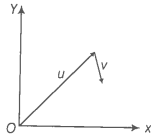
which of the following is correct?
a) a and p are positive while b and q are negative
b) a, p, and b are positive while q is negative
c) a, q, and b are positive while p is negative
d) a, b, p, and q are all positive
NEETprep Answer
4.4. The component of a vector r along the X-axis will have maximum value if
a) r is along positive Y-axis
b) r is along positive X-axis
c) r makes an angle of 45o with the X-axis
d) r is along the negative Y-axis
NEETprep Answer
4.5. The horizontal range of a projectile fired at an angle of 15o is 50 m. If it is fired with the same speed at an angle of 45o, its range will be
a) 60 m
b) 71 m
c) 100 m
d) 141 m
NEETprep Answer
4.6. Consider the quantities of pressure, power, energy, impulse gravitational potential, electric charge, temperature, area. Out of these, the only vector quantities are
a) impulse, pressure, and area
b) impulse and area
c) area and gravitational potential
d) impulse and pressure
NEETprep Answer
4.7. In a two-dimensional motion, instantaneous speed is a positive constant. Then which of the following are necessarily true?
a) the average velocity is not zero at any time
b) average acceleration must always vanish
c) displacements in equal time intervals are equal
d) equal path lengths are traversed in equal intervals
NEETprep Answer
4.8. In a two-dimensional motion, instantaneous speed is a positive constant. Then which of the following are necessarily true?
a) the acceleration of the particle is zero
b) the acceleration of the particle is bounded
c) the acceleration of the particle is necessarily in the plane of motion
d) the particle must be undergoing a uniform circular motion
NEETprep Answer
4.9. Three vectors A, B, and C add up to zero. Find which is false
a) vector (A×B)C is not zero unless vectors B, C are parallel
d) vector (A×B).C is not zero unless vectors B, C are parallel
c) if vectors A, B, C define a plane, (A×B)C is in that plane
d) (A×B).C = |A||B||C| C2 = A2 + B2
NEETprep Answer
4.10. It is found that |A + B| = |A|. This necessarily implies
a) B = 0
b) A, B are antiparallel
c) A, B are perpendicular
d) A.B ≤ 0
NEETprep Answer
EXEMPLAR QUESTIONS
4.11. Two particles are projected in the air with speed v0, at angles θ1 and θ2 to the horizontal, respectively. If the height reached by the first particle is greater than that of the second, then tick the right choices
a) angle of the project: q1 > q2
b) time of flight: T1 > T2
c) horizontal range: R1 > R2
d) total energy: U1 > U2
NEETprep Answer
4.12. A particle slides down a frictionless parabolic track starting from rest at point A. Point B is at the vertex of the parabola and point C is at a height less than that of point A. After C, the particle moves freely in the air as a projectile. If the particle reaches the highest point at P, then
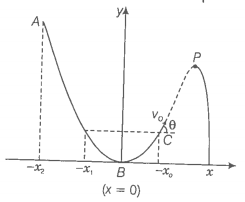
a) KE at P = KE at B
b) height at P = height at A
c) total energy at P = total energy at A
d) time of travel from A to B = time of travel from B to P
NEETprep Answer
4.13. The following are four different relations about displacement, velocity, and acceleration for the motion of a particle in general. Choose the incorrect one (s):
a) vav = 1/2 [v(t1) + v(t2)]
b) vav = r(t2)-r(t1)/t2-t2
c) r = 1/2 [v(t2)-v(t1)](t2-t1)
d) aav = v(t2)-v(t1)/t2-t1
NEETprep Answer
4.14. For a particle performing uniform circular motion, choose the correct statement from the following:
a) magnitude of particle velocity (speed) remains constant
b) particle velocity remains directed perpendicular to the radius vector
c) direction of acceleration keeps changing as particle moves
d) angular momentum is constant in magnitude but direction keeps changing
NEETprep Answer
4.15. For two vectors A and B, |A+B=|A - B| is always true when
a) |A| = |B| 0
b)
c) |A| = |B| 0 and A and B are parallel or antiparallel
d) when either |A| or |B| is zero
NEETprep Answer
4.16. A cyclist starts from center O of a circular park of radius 1 km and moves along the path OPRQO as shown in the figure. If he maintains a constant speed of 10 m/s, what is his acceleration at point R in magnitude and direction?
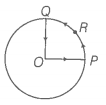
4.17. A particle is projected in the air at some angle to the horizontal, moves along parabola as shown in the figure, where x and y indicate horizontal and vertical directions respectively. Show in the diagram, direction of velocity and acceleration at points A, B, and C.
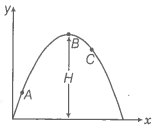
4.18. A ball is thrown from a rooftop at an angle of 45o above the horizontal. It hits the ground a few seconds later. At what point during its motion, does the ball have
a) greatest speed
b) smallest speed
c) greatest acceleration?
NEETprep Answer
4.19. A football is kicked into the air vertically upwards. What is its
a) acceleration
b) velocity at the highest point
NEETprep Answer
4.20. A, B, and C are three non-collinear, non-co-planar vectors. What can you say about the direction of A(B × C)?
NEETprep Answer
EXEMPLAR QUESTIONS
4.21. A boy traveling in an open car moving on a labeled road with constant speed tosses a ball vertically up in the air and catches it back. Sketch the motion of the ball as observed by a boy standing on the footpath. Give an explanation to support your diagram.
NEETprep Answer
4.22. A boy throws a ball in the air at 60o to the horizontal along a road with a speed of 10 m/s. Another boy sitting in passing by car observes the ball. Sketch the motion of the ball as observed by the bot in the car, if the car has a speed of 18 km/h. Give an explanation to support your diagram.
NEETprep Answer
4.23. In dealing with the motion of a projectile in the air, we ignore the effect of air resistance on the motion. This gives trajectory as a parabola as you have studied. What would the trajectory look like if air resistance is included? Sketch such a trajectory and explain why you have drawn it that way.
NEETprep Answer
4.24. A fighter plane is flying horizontally at an altitude of 1.5 km with a speed of 720 km/h. At what angle of sight when the target is seen, should the pilot drop the bomb in order to attack the target?
NEETprep Answer
4.25. a) Earth can be thought of as a sphere of radius 6400 km. Any object is performing circular motion around the axis of earth due to earth’s rotation. What is acceleration of object on the surface of the earth towards its centre? What is it at latitude θ? How does these accelerations compare with g = 9.8 m/s2?
b) Earth also moves in circular orbit around sun once every year with an orbital radius of 1.5 × 1011m. What is the acceleration of earth towards the centre of the sun? How does this acceleration compare with g = 9.8 m/s2?
NEETprep Answer
4.26 Given below in column I are the relations between vectors a, b, and c, and in column II are the orientations of a, b, and c in the XY plane. Match the relation in column I to correct orientations in column II.
Column I |
Column II |
(a) A + b = c |
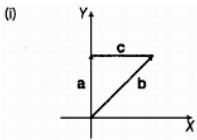 |
(b) A - c = b |
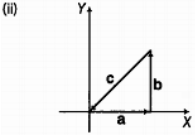 |
(c) b - a = c |
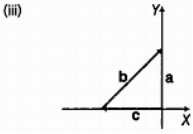 |
(d) a + b + c = 0 |
 |
NEETprep Answer
4.27. If |A| = 2 and |B| = 4, then match the relations in column I with the angle between θ between A and B in column II.
Column I Column II
(a) AB = 0 (i)
(b) AB + 8 (ii)
(c) AB = 4 (iii)
(d) AB = -8 (iv)
NEETprep Answer
4.28. If |A| = 2 and |B| = 4, then match the relations in column I with the angle θ between A and B in column II.
Column I Column II
(a) |A x B| = 0 (i)
(b) |A x B| = 8 (ii) 45°
(c) |A x B| = 4 (iii)
(d) |A x B| = 4 (iv)
NEETprep Answer
4.29. A hill is 500 m high. Supplies are to be sent across the hill using a canon that can hurl packets at a speed of 125 m/s over the hill. The canon is located at a distance of 800 m from the foot of the hill and can be moved on the ground at a speed of 2 m/s so that its distance from the hill can be adjusted. What is the shortest time in which a packet can reach on the ground across the hill? Take g = 10 m/s2.
NEETprep Answer
4.30. A gun can fire shells with maximum speed v0 and the maximum horizontal range that can be achieved is . If a target farther away by distance ∆x has to be hit with the same gun, show that it could be achieved by raising the gun to a height at least
This problem can be approached in two different ways
(i) Refer to the diagram, target T is at a horizontal distance and between the point of projection y = - h.
(ii) From point P in the diagram projection at speed vo at an angle 0 below horizontal with height h and horizontal range (rA)
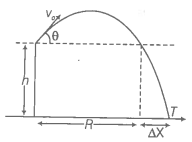
EXEMPLAR QUESTIONS
4.31. A particle is projected in the air at an angle β to a surface which itself is inclined at an angle α to the horizontal.
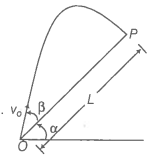
a) find an expression of range on the plane surface
b) time of flight
c) β at which range will be maximum
NEETprep Answer
4.32. A particle falling vertically from a height hits a plane surface inclined to horizontal at an angle θ with speed v0 and rebounds elastically. Find the distance along the plane where it will hit the second time.
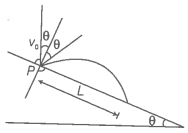
4.33. A girl riding a bicycle with a speed of 5 m/s towards north direction, observes rain falling vertically down. If she increases her speed to 10 m/s, rain appears to meet her at 45o to the vertical. What is the speed of the rain? In what direction does rainfall as observed by a ground-based observer?
NEETprep Answer
4.34. A river is flowing due east with a speed 3 m/s. A swimmer can swim in still water at a speed of 4 m/s.
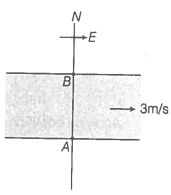
a) if swimmer starts swimming due north, what will be his resultant velocity?
b) if he wants to start from point A on south bank and reach opposite point B on north bank,
i) which direction should he swim?
ii) what will be his resultant speed?
c) from two different cases as mentioned in a) and b) above, in which case will he reach opposite bank in shorter time?
NEETprep Answer
4.35. A cricket fielder can throw the cricket ball with a speed vo. If he throws the ball while running with speed u at an angle θ to the horizontal, find
a) the effective angle to the horizontal at which the ball is projected in the air as seen by a spectator
b) what will be the time of flight?
c) what is the distance from the point of projection at which the ball will land?
d) find θ at which he should throw the ball that would maximize the horizontal range as found c)
e) how does θ for maximum range change if ?
f) how does θ in e) compare with that for u = 0?
NEETprep Answer
4.36. Motion in two dimensions, in a plane, can be studied by expressing position, velocity, and acceleration as a vector in Cartesian coordinates where i and j are unit vectors along x and y directions, respectively and Ax and Ay are corresponding components of A. Motion can also be studied by expressing vectors in circular polar coordinates as where are unit vectors along the direction in which r and θ are increasing.
a) express in terms of .
b) show that both are unit vectors and are perpendicular to each other
c) show that
d) for a particle moving along a spiral given by where a = 1 find dimensions of ‘a’
e) find velocity and acceleration in polar vector representation for a particle moving along spiral described in d) above
NEETprep Answer
4.37. A man wants to reach from A to the opposite comer of the square C. The sides of the square are 100 m. A central square of 50 m × 50 m is filled with sand. Outside this square, he can walk at a speed of 1 m/s. In the central square, he walks only at a speed of v m/s. What is the smallest value of v for which he can reach faster via a straight path through the sand than any path in the square outside the sand?
